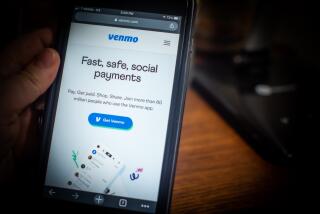Checking Account Can Be a Good Spot for Cash
- Share via
Continuing volatility has millions of investors fleeing stocks and bonds for money market mutual funds, which are seen as safe parking spots for cash.
In the last three months, individuals have poured about $28 billion into money market mutual funds, according to the Investment Company Institute in Washington. It is the first sustained rise in this figure since 1989, ICI spokeswoman Malin Jennings said.
Yet, oddly enough, in today’s environment of rising bank fees and high tax rates, a far more lucrative--and equally safe--option may be your checking account.
The combination of interest earnings and “waived” checking fees can net investors more than 8% on their money--a generous return for cash that’s readily available and fully insured by the federal government. Clearly, it is far more generous than the 2.5% to 3% investors are currently earning in money market mutual funds.
Consider what’s offered at San Francisco-based Bank of America.
The bank will waive its $9 monthly fee for customers who maintain a $1,500 daily balance in an interest-bearing checking account. Customers also earn 1% on the $1,500. The $15 in annual interest and the $108 saved on monthly fees nets $123 on the $1,500 deposit. In effect, that is an interest rate of 8.2%.
Notably, the bank’s regular checking account works out to a better deal--even though you don’t earn interest on the balance--because the balance required to waive the service fee is lower. If you keep $750 in a regular checking account, Bank of America will waive the $7.50 monthly fee. That works out, in effect, to a yield of 12%.
And BofA is not alone. Thousands of banks and thrifts in California and all over the country are offering similar deals, and they have been for some time. An American Bankers Assn. survey conducted in 1993 found that more than 70% of the nation’s commercial banks would waive checking account fees averaging between $6 and $7 a month for customers who kept at least $1,000 in their accounts. That works out to a return of between 7.2% and 8.4%.
Until recently, many investors didn’t bother to maintain a minimum checking balance because they were earning double-digit returns in the stock and bond markets. That argued for investing all of one’s available cash and simply paying the checking account fees.
Now, as the direction of the financial markets looks less certain, the picture has changed. Investors are looking for safe places to park their cash anyway, so keeping at least the minimum balance in a checking account begins to look attractive.
Some banks say they’ve already seen a shift.
“We’ve noticed a big increase in our balances in the last three months, and we decided that this must be the reason,” said Lisabeth Weiner at First National Bank of Chicago. “People who were just looking for parking places for their cash went into savings.”
Is a fee waiver really the same as earning interest on your money? No. In some ways, it’s better.
That’s because a waived fee is not taxable income. Someone in the 30% tax bracket would have to earn $154 to pay Bank of America’s $108 annual checking fees, simply because federal and state governments take a portion of all earnings--interest or otherwise. So the person who invests elsewhere must earn a taxable yield of 10.2% to be even with the person who keeps $1,500 in a checking account to avoid $108 a year in fees.
What’s the catch? This is a bargain only if you ordinarily pay fairly stiff monthly fees on your checking account. Some senior citizens and people with limited check-writing needs pay significantly less for checking services than customers who need accounts with unlimited check-writing privileges.
Moreover, certain types of balance requirements are particularly unforgiving. Minimum daily balances, for example, are far more difficult to meet than “average balance” requirements. That’s because, under the minimum balance rule, you’ll end up paying the monthly fee if you dip below the balance requirement at any time during the month--even for just one day. With the average-balance method, you can generally compensate for short lapses by having a larger balance on other days.
Finally, if you keep more than the minimum amount required, your return drops substantially. That’s because bank interest rates are still nothing to write home about. The main benefit of keeping the balance is having the bank fees waived.
Check It Out
Here is a sampling of California banks and thrifts that will waive monthly checking fees if you maintain a minimum balance.
Monthly Balance required Effective Bank fees to waive the fee* yield Wells Fargo $9** $750 14.4% First Interstate 8 750 12.8 Bank of America 7.50 750 12.0 Home Savings 7 750 11.2 Great Western Bank 7 750 11.2
* Minimum daily
** Charge is reduced for customers who have their paychecks deposited directly into their accounts and for those who don’t want their checks returned to them.
Note: Most banks offer several checking options. Only one option is compared.
More to Read
Inside the business of entertainment
The Wide Shot brings you news, analysis and insights on everything from streaming wars to production — and what it all means for the future.
You may occasionally receive promotional content from the Los Angeles Times.










